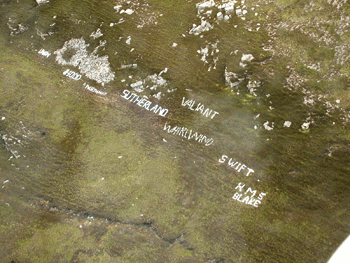
Mackay Country
Dùthaich Mhic Aoidh
An area in North-West Scotland of natural unspoiled beauty, rich in heritage & history
Laid

Down the west side of Loch Eriboll is the strung out crofting township of Laid. This was created in 1832 to house people cleared from Eriboll, on the far side of the loch, to make way for sheep. Today it is made up of 18 crofts, and after many decades of steady decline that included the closure of the school in 1955. It is now home to seven families on a permanent basis.
“The nickname of “Croppies” was associated to the Laid population while the people of Durness were called “Machairich” or field people. The first settlements in Laid are said to have arrived around 1835 from Eriboll farm.”
Laid is the village on the west shore of Loch Eriboll with 18 crofts. Loch Eriboll, Hoan Fjord, is a lengthy and deep sea loch about sixteen kilometers long with a south – west direction and varying from one point five to six point five kilometers in breadth.


The view to the east is over Loch Eriboll to the island of Eilean Choraidh and Ben Hope, the most northerly Munro. A long defile of single and one and a half storey cottages, set on a rugged and rocky coastline, on the A838 Durness to Tongue road. Each cottage, many now ruins or replaced with modern bungalows and a patch of land, enclosed by a massive dry-stone dyke constructed of stone cleared from the land to create patches of soil able to be cultivated. A rocky near lunar landscape and barren land contrasting with the greenness of Eriboll on the east side of the sea loch .
The sea loch with diverse and plentiful supplies was the main provider of food. The nickname of “Croppies” was associated to the Laid population while the people of Durness were called “Machairich” or field people. The first settlements in Laid are said to have arrived around 1835 from Eriboll farm. They were joined by in 1841/42 by others evicted from Rispond. Laid provides stark evidence of the hardships endured by the clearances, the allocated ground is hardly arable. there is no trace in Laid of any earlier settlement than 1835 nor any archeological feature. For thousands of years people found the area too poor too settle on. from 1835 crofters strove to improve the ground but productivity has always been low.
A small gabled former school and schoolhouse built in 1894 of local rubble, reddish-tooled dressing and tall chimney stacks is now a holiday home. The role was about an attendance of forty children at that time. The school was frequently used for dances and occasional weddings. There are many stories of a hard but happy life style in this community. Kelp was harvested in this area for the manufacture of soap and glass to supplement wages but returns for hard labor were very small. It was not until September 1982 the first mains electricity arrived in Laid .
This loch has been used as a naval anchorage for much of the 20th century. When ships anchored in Loch Eriboll in the 1920s and 1930s some crew members would climb the hill to the west of the loch and leave their ship’s name written in stone letters about two meters high in a patch one by two meters. The most prominent is the HOOD and it is the Hood’s tragic history that makes the hillside such a poignant spot. The well preserved iron age wheel house is one of the best in Scotland and is a scheduled ancient monument.. There are eight bronze age cairns although some are difficult to make out. Details on Laid Heritage Trail

